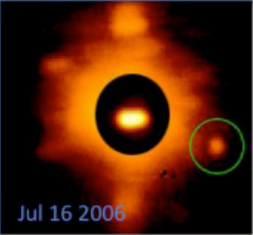
624 Hektor is the largest Jupiter trojan and the namesake of the Hektor family, with a highly elongated shape equivalent in volume to a sphere of approximately 225 to 250 kilometers diameter. It was discovered on 10 February 1907, by astronomer August Kopff at Heidelberg Observatory in southwest Germany, and named after the Trojan prince Hector, from Greek mythology. It has one small 12-kilometer sized satellite, Skamandrios, discovered in 2006.

2685 Masursky, provisional designation 1981 JN, is a stony Eunomian asteroid from the central regions of the asteroid belt, approximately 11 kilometers in diameter. It was discovered on 3 May 1981, by American astronomer Edward Bowell at the Anderson Mesa Station near Flagstaff, Arizona, and named after American planetary geologist Harold Masursky. In January 2000, the Cassini space probe observed the S-type asteroid from afar during its coast to Saturn.
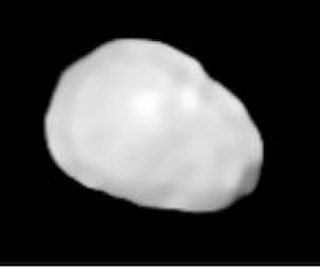
Eunomia is a very large asteroid in the middle asteroid belt. It is the largest of the stony (S-type) asteroids, with 3 Juno as a close second. It is quite a massive asteroid, in 6th to 8th place. It is the largest Eunomian asteroid, and is estimated to contain 1% of the mass of the asteroid belt.

Ariadne is a fairly large and bright main-belt asteroid. It is the second-largest member of the Flora asteroid family. It was discovered by N. R. Pogson on 15 April 1857 and named after the Greek heroine Ariadne.
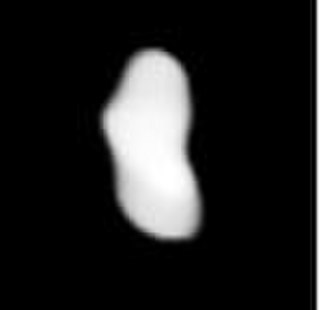
Ausonia is a stony Vestian asteroid from the inner region of the asteroid belt, approximately 100 kilometers in diameter. It was discovered by Italian astronomer Annibale de Gasparis on 10 February 1861, from the Astronomical Observatory of Capodimonte, in Naples, Italy. The initial choice of name for the asteroid was "Italia", after Italy, but this was modified to Ausonia, an ancient classical name for the Italian region.
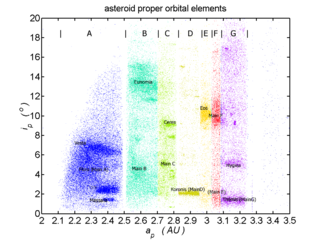
An asteroid family is a population of asteroids that share similar proper orbital elements, such as semimajor axis, eccentricity, and orbital inclination. The members of the families are thought to be fragments of past asteroid collisions. An asteroid family is a more specific term than asteroid group whose members, while sharing some broad orbital characteristics, may be otherwise unrelated to each other.
The Vesta family is a family of asteroids. The cratering family is located in the inner asteroid belt in the vicinity of its namesake and principal body, 4 Vesta. It is one of the largest asteroid families with more than 15,000 known members and consists of mostly bright V-type asteroids, so-called "vestoids".
The Eos family is a very large asteroid family located in the outer region of the asteroid belt. The family of K-type asteroids is believed to have formed as a result of an ancient catastrophic collision. The family's parent body is the asteroid 221 Eos.
The Gefion family is an asteroid family located in the intermediate asteroid belt between 2.74 and 2.82 AU at inclinations of 7.4° to 10.5°. The family of S-type asteroids is named after 1272 Gefion and consists of more than 2,500 known members. It had previously been known as the Ceres family. It is still known as Minerva family, named after then thought parent body 93 Minerva, until it was identified to be an interloper into its own family.
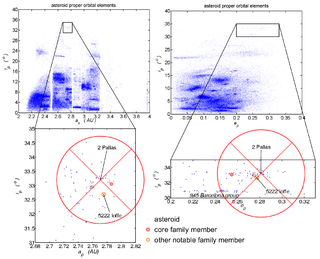
The Pallas family is a small asteroid family of B-type asteroids at very high inclinations in the intermediate asteroid belt.
817 Annika is a background asteroid in the region of the Eunomia family, located in the central portion of the asteroid belt. It was discovered on 6 February 1916, by German astronomer Max Wolf at the Heidelberg-Königstuhl State Observatory in southwest Germany. The stony S-type asteroid (Sl) has a rotation period of 10.56 hours and measures approximately 23 kilometers in diameter. Any reference of the asteroid's name to a person is unknown.
848 Inna is a carbonaceous Themistian asteroid from the outer regions of the asteroid belt. It was discovered on 5 September 1915, by astronomer Grigory Neujmin at the Simeiz Observatory on the Crimean peninsula. The C-type asteroid measures approximately 33 kilometers in diameter, while its rotation period remains unknown. It was named after Russian astronomer Inna Nikolaevna Leman-Balanovskaya (1881–1945).

867 Kovacia is an elongated, dark asteroid and member of the Hygiea family from the outer regions of the asteroid belt. It was discovered on 25 February 1917, by astronomer Johann Palisa at the Vienna Observatory in Austria. The carbonaceous C/B-type asteroid has a rotation period of 8.7 hours and measures approximately 24 kilometers in diameter. It was named after Austrian physician Friedrich Kovacs (1861–1931).

812 Adele is an elongated Eunomia asteroid from the central regions of the asteroid belt. It was discovered on 8 September 1915, by Russian astronomer Sergey Belyavsky at the Simeiz Observatory on the Crimean peninsula. The presumed S-type asteroid has a rotation period of 5.9 hours and measures approximately 13 kilometers in diameter. It was likely named after the character "Adele" in the opera Die Fledermaus by Johann Strauss.
845 Naëma is a large asteroid and the parent body of the Naëma family located in the outer regions of the asteroid belt. It was discovered on 16 November 1916, by astronomer Max Wolf at the Heidelberg-Königstuhl State Observatory in southwest Germany. The carbonaceous C-type asteroid has a rotation period of 20.9 hours and measures approximately 54 kilometers in diameter on average, as it is likely elongated in shape. Any reference of the asteroid's name to a person is unknown.

The Juno clump is a probable main-belt asteroid family that share similar orbital elements to 3 Juno.

The Flora family is a prominent family of stony asteroids located in the inner region of the asteroid belt. It is one of the largest families with more than 13,000 known members, or approximately 3.5% of all main-belt asteroids.
The Hygiea or Hygieanfamily is a grouping of dark, carbonaceous C-type and B-type asteroids in outer asteroid belt, the largest member of which is 10 Hygiea. About 1% of all known asteroids in the asteroid belt belong to this family.
The Massalia family is a family of asteroids in the inner asteroid belt, named after its parent body, 20 Massalia. It consists of S-type asteroids with very low inclinations, straddling the 1:2 resonances with Mars. There are more than 6,000 known Massalian asteroids.
The Nysa family is part of the Nysa–Polana complex, the largest cluster of asteroid families in the asteroid belt. It is located in the inner region of the asteroid belt, orbiting the Sun between 2.41 and 2.5 AU. Asteroids in this complex have eccentricities between 0.12 and 0.21 and inclinations of 1.4 to 4.3. The family derives its name from its most massive member, 44 Nysa. It has also been known as the Hertha family(adj. Herthian) named after 135 Hertha.










